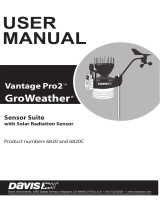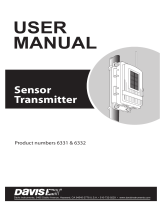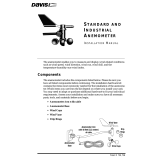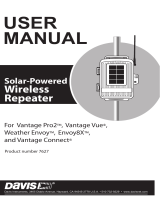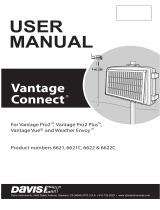Page is loading ...

1
ANEMOMETER TRANSMITTER KIT
INSTALLATION MANUAL
This manual describes how to install the Anemometer Transmitter Kit for a Wireless
Vantage Pro2TM Weather Station. The kit enables you to connect the anemometer from
your Integrated Sensor Suite (ISS) to its own transmitter, so it can be located away from
the ISS and communicate directly with your
console/receiver.
Components
The Anemometer Transmitter Kit includes the following components and mounting
hardware:
1/4" Flat Washers
1/4" Lock Washers
1/4" Hex Nuts
3-Volt
Lithium
Battery
U-Bolts
1/4" x 1-1/2" Lag Screws
8" Cable Ties
Transmitter Shelter
#6 x 1/2" (3.5 x 12 mm)
Self-Threading Screw
#6 Washer
Cable Clamp
Tools for Setup
In addition to the kit, you will need some or all of the following materials:
• Adjustable wrench or 7/16" wrench
• Compass or local area map
• Ballpoint pen or paper clip (small pointed object of some kind)
• Drill and 3/16" (5 mm) drill bit (if mounting on a vertical surface)
• Carpenter’s level (if mounting on a vertical surface)
If You Are Installing the ISS and the Anemometer Transmitter Kit
at the Same Time
Install your ISS first, following the instructions in the ISS manual. However, during the
step “Preparing the ISS for Installation,” DO NOT connect the anemometer cable to the
SIM. When you have mounted the rain collector side of the ISS and are ready to mount
the anemometer, follow the instructions in this manual starting with “Preparing the
Anemometer Transmitter” on page 3.

2
Installation Steps
The following is an outline of the steps necessary to install the Anemometer Transmitter
Kit. These steps are used as section headings in this manual and are explained in greater
detail in the appropriate section.
• Remove the anemometer from its current location (if necessary)
• Disconnect the anemometer from the ISS transmitter
• Unfasten and remove the anemometer
• Prepare the anemometer transmitter
• Insert the battery
• Plug the anemometer cable into the transmitter
• Set the transmitter ID on the anemometer transmitter using DIP switches
• Set the console to recognize the signals
• View current wind data
• Putting your anemometer transmitter into TEST mode
• Choose a location for the anemometer transmitter
• Test transmission from the proposed mounting location
• Mount the anemometer and transmitter shelter in the new location
• A note on securing cables
• Troubleshooting
• Contacting Davis Technical Support
Removing the Anemometer from its Current Location
The following two steps assume that your ISS is already mounted. If it is in a high
location such as a rooftop, please read through the instructions before climbing up, and
watch your balance while installing your Anemometer Transmitter Kit.
Disconnecting Anemometer from ISS Transmitter
Open the SIM Box and unplug the anemometer cable from the receptacle labeled WIND
on the SIM. Guide the anemometer cable through and free from the grommet. Or in the
case of the Vantage Pro2 SIM Box, guide the anemometer cable free of the cable access
port by first removing the foam insert and then guiding the cable out of the box. When
finished, make sure to replace the foam insert ensuring that the Access Port is filled and
free of any voids.
If Your ISS is Mounted as a Single Unit (Both Sides Together on
a Pole)
Unfasten the anemometer:
1. Remove the black rain collector cone from its base by rotating cone counter-
clockwise until its latches line up with openings in the base and you can lift it off. It is
much easier to reach the hex nuts with a wrench if you remove the rain collector cone
first.
2. Using an adjustable wrench or 7/16" wrench, remove the hex nuts and washers
holding the anemometer’s plastic mounting base on the pole. Set the anemometer
down for a moment.

3
3. Remove the hex nuts and washers holding the rain collector side on the pole. Retrieve
the U-bolt that was holding the anemometer.
4. Using the washers and hex nuts, fasten the rain collector side back onto the pole. Flat
washer goes on first, then lock washer, then hex nut.
5. Put the rain collector cone back on. Rotate the cone clockwise until the latches slide
into place.
If Your Anemometer is Mounted by Itself
Unfasten it: use an adjustable wrench or 7/16" wrench to remove the hex nuts or lag
screws.
Preparing the Anemometer Transmitter
The illustration below shows the Sensor Interface Module, or “SIM”, inside the
transmitter shelter.
1. Insert the 3-volt
lithium battery into
the battery holder,
matching the “+” sign
on the battery with the
“+” sign on the SIM.
3-Volt
Lithium Battery
DIP Switch
es
Cable Clam
p
Mount
Anemometer
Cable
Square Black Grommets
SENSOR
SENSOR
INTERFACE
INTERFACE
MODULE
MODULE
UV
UV
SUN
SUN
RAIN
RAIN
WIND
WIND
TEMP
TEMP
HUM
HUM
+
-
Cable Clamp
Test LED
2. Push the end of the
anemometer cable up
through the square
black grommet into
the transmitter shelter.
Every Davis shelter
has two of these
grommets to provide
weather-resistant
entrances for cables.
In this case, use the
grommet on the right.
You can also remove
the grommet, thread
the cable through it
and then replace the
grommet in the shelter
if that is easier for
you.
3. Plug the end of the anemometer cable into the receptacle labeled WIND on the SIM.
4. Place the cable clamp over the anemometer cable between the grommet and the
receptacle. Secure the cable clamp to the shelter by threading the provided #6 screw
through the washer, then cable clamp and then screwing it into the cable clamp mount
inside the housing. (See the above illustration.)
5. Locate the DIP switches. You will work with them during the next installation step.

4
Setting the Transmitter ID
Each wireless transmitting station must be set to one of eight transmitter IDs. DIP
switches #1, 2 and 3 on the SIM allow you to control the ID — the “channel” the station
will transmit on. (DIP switch #4 is used for transmission testing, not for transmitter ID.)
Note: The transmitter and your console communicate with each other only when both are set to the
same ID.
The factory default transmitter ID is ‘1’. Looking at the table below, you can see that
means all three DIP switches are in the OFF position when each transmitting station
leaves the factory, whether it is an ISS, an anemometer transmitter, or another kind of
station.
The ISS is included with every Wireless Vantage Pro, and the console/receiver is factory
set to find the ISS on ‘1’. Since it is likely that your ISS is already set to ID ‘1’, you
will need to set the ID of your anemometer transmitter to a different ID number.
Use a ballpoint pen or paper clip to toggle DIP switches #1, 2, and 3. The settings for
transmitter IDs 1 – 8 are shown in the table below:
ID CODE SWITCH 1 SWITCH 2 SWITCH 3
#1 (default) off off off
#2 off off ON
#3 off ON off
#4 off ON ON
#5 ON off off
#6 ON off ON
#7 ON ON off
#8 ON ON ON
Use this table to ensure that each wireless transmitting station in your system is
broadcasting on its own transmitter ID.
1234
ON
Battery Holder
DIP Switches
DIP SWITCHES IN TOP-RIGHT CORNER OF SIM (ILLUSTRATION HAS BEEN ENLARGED FOR CLARITY)

5
Setting Console/Receiver(s) to Same ID
1. Put your console into Setup Mode — press and hold DONE and press the DOWN
arrow (-).
• Vantage Pro2: The console will show Screen 1: Transmitters.
• Vantage Vue: Press and release DONE until you get to Screen 5: Active
Transmitters.
You should see the words: “RECEIVING FROM...” and “STATION NO.”
followed by the transmitter IDs that your console detects. One of these should be
the ID number you just set on the anemometer transmitter. It may take one to two
minutes for the station ID to appear. If you don’t see it, verify that you set the DIP
switches correctly. If you still don’t see it, go to “Test Mode” on the next page.
2. Press DONE to move on to Screen 2: Selecting Transmitters (Vantage Pro2) or
Screen 6: Configuring Transmitter IDs (Vantage Vue). This is where you will set the
console to recognize signals on that transmitter ID as coming from an anemometer
transmitter.
3. Press the LEFT or RIGHT arrows to scroll through the transmitter IDs. When you see
the ID you chose for the anemometer, press the UP (+) or DOWN (-) arrows to
activate reception of that ID code. Make sure the screen shows “ON”.
4. Press GRAPH to change the type of station assigned to that transmitter ID. Press
GRAPH until the word “WIND” appears.
5. To exit Setup Mode, press and hold DONE.
The console/receiver will display wind readings from one anemometer in the
compass rose. Once you set the ID code, it makes no visible difference that the
readings are now being sent by the anemometer transmitter instead of the ISS
transmitter.
Viewing Current Wind Data
You should now see wind direction and speed displaying in the compass rose on the
console screen. Press WIND if necessary to alternate between speed and direction. Spin
the wind cups. Turn the wind vane, and allow 5 seconds for the wind direction display to
stabilize before moving it again.
Display of current wind data confirms communication between your anemometer
transmitter and the console. Go on to “Choosing a Location for the Anemometer
Transmitter” on page 6.
If You Do Not See Current Wind Readings
First, verify that the console/receiver is powered and is not in Setup Mode (exit Setup
Mode by pressing DONE and holding it for a moment). Then, on the transmitter, ensure
that the anemometer sensor cable is firmly plugged into the jack that is labeled WIND
on the SIM. Check that the battery is properly installed. Walk around the room with the
console, standing for a few moments in various locations to see if you are picking up
signals.
If you don’t see wind readings no matter where you stand with the console, put your
anemometer transmitter in Test Mode.

6
Test Mode
DIP switch #4 on the SIM (see illustration on page 6) is the TEST DIP switch. Switch it
to the ON position using a ball-point pen or paper clip. This puts the transmitter in Test
Mode. An LED indicator light, located below the jack to the right of the battery on the
SIM, will flash each time the transmitter broadcasts a signal, which should be every 2.5
seconds.
If the LED flashes only once and then remains dark, there is a problem with the
anemometer transmitter. See “Contacting Davis Instruments” on page 11.
If the LED flashes repeatedly but your console isn’t picking up a signal anywhere in the
room, it could be related to one of the following causes:
1. The DIP switches were not correctly set on the transmitter. Review the procedure on
page 4.
2. The ID was not correctly set on the console/receiver. Review the procedure on page
5.
3. Reception is being disrupted by RF (radio frequency) interference. Interference has to
be very strong to prevent the console from receiving a signal while in the same room
as the anemometer transmitter!
4. There is a problem with the console/receiver. See “Contacting Davis Instruments” on
page 11.
Note: Remember to turn the Test DIP switch OFF when you’re finished testing wireless transmission.
If it is left ON, the blinking LED will reduce battery life significantly.
Choosing a Location for the Anemometer Transmitter
Keep the following factors in mind as you choose a location for your anemometer and
the transmitter shelter:
• Mount the anemometer at least 4' (1.2 m) above the roofline for accurate wind
readings. As shown in the ISS manual, the anemometer can be mounted on a pole
or on a vertical surface such as a wooden post. It comes with 40' (12 m) of cable
to connect to the transmitter shelter.
• Mount the transmitter shelter nearby, with the solar panel facing the sun. In the
Northern Hemisphere, position the transmitter shelter with solar panel facing
south, for maximum sun exposure. (In the Southern Hemisphere, position the
shelter with solar panel facing north.)
• If you need to increase the distance between your anemometer and the transmitter
shelter, use extension cables #7876 from Davis Instruments. Please be aware that
maximum wind speed reading decreases as the total length of cable from the
anemometer to the ISS increases. If this distance is greater than 240' (73 m),
maximum wind speed may be less than 100 mph (161 kph).
Note: Not all cables are compatible with your Vantage Pro2 system. To be sure they will work, order
extension cables from your dealer or directly from Davis Instruments.

7
Range of Wireless Transmission
The range of your radio transmission depends on many factors. Try to position the
transmitter shelter and your console/receiver as close as possible for best results.
Range is up to 1000' (300 m), line of sight, under optimal conditions. Typical range
under most conditions is 200' to 400' (60 to 120 m), but this may be reduced by walls,
ceilings, trees, or foliage. Radio-frequency interference (RF) can also reduce
transmission distance. Cordless phones (900 MHz) and ham radios are common
examples of RF interference.
A metal roof or other large metal structure can interfere with the signal (aluminum
siding, a furnace with metal ducts, and your refrigerator are examples). Sometimes
transmission between wireless units is obscured by something you cannot identify, or by
some obstacle that you can’t work around. If necessary, consider using Wireless
Repeater #7626 or #7627 to strengthen the signal or increase the distance between the
anemometer transmitter and the console/receiver.
Testing Transmission from Proposed Location
It is very important to test reception from the proposed location before permanently
mounting the anemometer transmitter shelter.
Place the transmitter shelter at the intended mounting site, or have someone hold it there,
so you can walk around with the console/receiver for a few minutes. Rotating the
antenna may help to improve reception.
Test wireless reception anywhere you might want to use or mount your console/receiver
now or in the future. Take your time. If you aren’t picking up strong signals where you
intend to place your console, better to move the transmitter shelter now than after it has
been mounted. Experiment.
If you have irregular terrain in the area, it may interfere with the signal. For example, if
the transmitter is mounted downhill from the console/receiver, the ground may block a
wide angle of the transmitted signal.
Mounting the Anemometer Transmitter
The anemometer can be mounted either on a pole or on a vertical surface such as a
fencepost. Remember to mount it so the anemometer arm is extending northward.
(Otherwise, you will need to calibrate the wind direction on your console to display
accurate wind directions. See your Vantage Pro2 or Vantage Vue console manual for
instructions.) The transmitter shelter also can be mounted on a pole or on a vertical
surface.
Mounting Anemometer on a Pole
1. While holding the mounting base against the pole, place a U-bolt around the pole and
through the two holes in the base.
2. Place a flat washer, a split washer and a hex nut on each of the bolt ends.

8
3. Swivel the
anemometer until
the arm is pointing
north, if possible.
U-Bolt
1/4" Flat Washer
1/4" Lock Washer
1/4" Hex Nut
4. Using an
adjustable wrench
or 7/16" wrench,
tighten the nuts. If
the anemometer
arm is not pointing
north, calibrate
your console by
following the
instructions in your
console manual.
Mounting Anemometer on a Vertical Surface
1. With a 3/16" (5 mm) drill
bit, drill two holes
approximately 2-1/8" (54
mm) apart. Use a
carpenter’s level to
ensure the holes will be
level.
1/4" Flat Washers
1/4" x 3" Lag Screw
s
40' of Anemometer Cable
2. Insert the 1/4" x 3" lag
screws through the flat
washers and the holes in
the mounting base into
the post.
3. Using an adjustable
wrench or 7/16" wrench,
tighten the lag screws. If
the anemometer arm is
not pointing north,
calibrate your console by
following the instructions
in your console manual.

9
Mounting Transmitter Shelter on a Pole
1. While holding the
shelter against the
pole, place a U-bolt
around the pole and
through the two
holes on at the top of
the shelter.
Flat
Washer
Lock
Washer
Hex
Nut
U-Bolt
2. Place a flat washer, a
lock washer and a
hex nut on each of
the bolt ends.
3. Using an adjustable
wrench or 7/16"
wrench, tighten the
nuts.
4. Place the second U-bolt around the pole and through the two holes at the bottom of
the shelter. Put a flat washer, a lock washer, and a hex nut on each bolt end, and
tighten the hex nuts.
Note: Remember to position the shelter so the solar panel has maximum exposure to the sun.
Mounting Transmitter Shelter on a Vertical Surface
1. With a 3/16" (5 mm) drill bit, drill two holes approximately 2" (50 mm) apart. Use a
carpenter’s level to ensure the holes will be level.
2. Drill two more holes 7-
1/32" below the upper
holes.
Flat
Washer
Lag
Screw
3. Insert the 1/4" x 1-1/2"
lag screws through the
flat washers, and through
the holes at the top of the
shelter into the post.
Using an adjustable
wrench or 7/16" wrench,
tighten the lag screws.
4. Insert the 1/4" x 1-1/2"
lag screws through the
flat washers, and through
the holes at the bottom of the shelter into the post. Using an adjustable wrench or
7/16" wrench, tighten the lag screws.
Note: Remember to position the shelter so the solar panel has maximum exposure to the sun.

10
A Note on Securing Cables
To prevent fraying or cutting of cables, secure
them so they will not whip about in the wind.
Secure a cable to a metal pole by wrapping
electrical tape around them both. Make sure cables
are secure by placing clips or ties approximately
every 3 – 5' (1 – 1.6 m).
Cable Clip Cable Tie
Note: Do not use metal staples or a staple gun to secure cables. Metal staples—especially when
installed with a staple gun—have a tendency to cut the cables.
If you haven’t used the entire length of anemometer cable, secure the remaining coil by
taping it to the pole, or hanging it on a hook on the post. Place the coil at least 6" away
from the antenna.
Troubleshooting
“The wind cups are spinning but my console only displays zero miles/hour.”
The signal from the wind cups is not making it back to the display. Check your cables
for visible nicks and cuts. Look for corrosion in the WIND jack on the Sensor
Interface Module and on splices in the cable (if any). If possible, remove any
extensions and try using the anemometer cable only. If none of these steps get the
wind speed working, call Technical Support at (510) 732-7814 to ask for a wind test
cable.
“The wind direction is stuck on north, or displays dashes.”
It is likely that there is a short or break somewhere between the wind vane and the
display. Check your cables for visible nicks and cuts. Look for corrosion in the
“WIND” jack on the Sensor Interface Module and on splices in the cable (if any). If
possible, remove any extensions and try with the anemometer cable only. If none of
these steps get the wind direction working, call Technical Support at (510) 732-7814
to ask for a wind test cable.
“The wind cups don’t spin as fast as they should. (Or don’t spin at all!)”
Either the anemometer is located where wind is blocked by something, or there is
friction interfering with the cups’ rotation. Friction usually can be remedied by the
user — remove the wind cups and clear out any bugs or debris. Turn the shaft the
cups rotate on. If it feels gritty or stiff, call Technical Support at (510) 732-7814. DO
NOT LUBRICATE THE SHAFT OR BEARINGS IN ANY WAY. When replacing
the cups, make sure they are not rubbing against any part of the anemometer head.
“Wind readings aren’t what I expected them to be.”
Be very careful. Comparing to measurements from TV, radio, newspapers, or a
neighbor is NOT a valid method of verifying your readings. Davis Instruments
sensors are carefully tested at the factory. If you have questions, contact Technical
Support.

11
Contacting Davis Instruments
(510) 732-7814 for Technical Support, Monday – Friday, 7:00 a.m. – 5:30 p.m. Pacific
Time.
(800) 678-3669 Toll-Free Order Line, Monday – Friday, 7:00 a.m. – 5:30 p.m. Pacific
Time. Our customer service representatives can answer most questions and assist you
with your purchases.
(510) 732-9229 For callers outside the USA or Canada.
(510) 670-0589 Fax to Customer Service or Tech Support.
www.davisnet.com Copies of User Manuals are available on the “Support” page.
Watch for FAQs and other updates. Subscribe to the e-newsletter.
[email protected] E-mail to Technical Support.
[email protected] E-mail to Customer Service.
[email protected] General e-mail.
Note: Please do not return items to the factory for repair without prior authorization.
Specifications
• Temperature range: –40 to 150° Fahrenheit (–40 to 65° Celsius)
• Wireless transmission frequency: 902 - 928 MHz
868.0 - 868.6 MHz FHSS for overseas version – Product # includes “OV”
• Transmitter ID codes: 8 user-selectable
• License: low power (less than 8 mW), no license required
• Primary power input: Solar power – Davis solar charger
• Secondary (backup) power: CR-123A 3-volt lithium battery or optional Vantage
AC power adapter

AnemometerTransmitterKitManual
ProductNumbers:6332,6332OV
DocumentPartNumber:07395.237
Rev.C,Manual(8/21/12)
VantagePro2™andVantageVue®aretrademarksofDavisInstrumentsCorp.,Hayward,CA.
Copyright©2012DavisInstrumentsCorp.Allrightsreserved.
ThisproductcomplieswiththeessentialprotectionrequirementsoftheECEMCDirectve2004/108/EC;Low
VoltageDirective2006/95/EC;andEco‐DesignDirective2005/32/EC>0.5wattno‐loadadapter.Davis
InstrumentsQualityManagementSystemisISO9001certified.
3465 Diablo Avenue, Hayward, CA 94545-2778 U.S.A.
510-732-9229 • Fax: 510-732-9188
E-mail: [email protected] • www.davisnet.com
®
FCC Part 15 Class B Registration Warning
This equipment has been tested and found to comply with the limits for a class B digital
device, pursuant to Part 15 of the FCC Rules. These limits are designed to provide
reasonable protection against harmful interference in a residential installation. This
equipment generates, uses and can radiate radio frequency energy and, if not installed
and used in accordance with the instructions, may cause harmful interference to radio
communications. However, there is no guarantee that interference will not occur in a
particular installation.
If this equipment does cause harmful interference to radio or television reception, which
can be determined by turning the equipment off and on, the user is encouraged to try to
correct the interference by one or more of the following measures:
• Reorient or relocate the receiving antenna.
• Increase the separation between the equipment and receiver.
• Connect the equipment into an outlet on a circuit different from that to which the
receiver is connected.
• Consult the dealer or an experienced radio/TV technician for help.
Changes or modifications not expressly approved in writing by Davis Instruments may
void the user's authority to operate this equipment.
/
